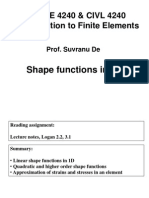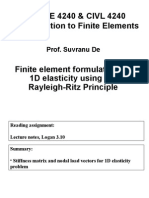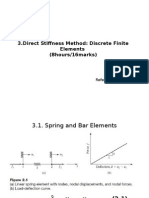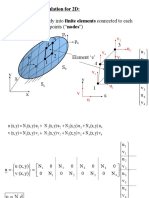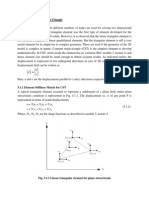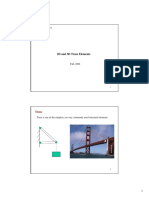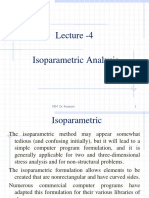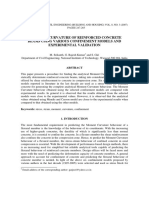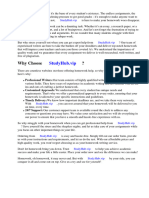DEVv2 Matlab Code For Computing FEM
Uploaded by
Anchel SalkDEVv2 Matlab Code For Computing FEM
Uploaded by
Anchel Salkclear all
clc
% FE Method in Structural Mechanics Assignment no. 1
% Angel Salesa - Nov 2017
% Introduction of the problem constants
elem =[1 2; 2 3; 1 4;2 4;2 5;4 5;3 5]; % Element
conectivity
real =[1184 1184 1184 1184 1184 1184 1184]; % Cross Section
Area
mat =[210e3 210e3 210e3 210e3 210e3 210e3 210e3]; % Young's modulus
lenght=[3e3 3e3 1.5e3*2^0.5 1.5e3*2^0.5 1.5e3*2^0.5 3e3 1.5e3*2^0.5]; % Element
length
angle=[0 0 45 135 45 0 135]; % Element orientation
%Creation of the global stiffness matrix from the local rigidity matrixes and the
%rotation matrix
K_ = zeros(10); % Inicialitation of global stiffness
for ielem = 1:7 % 7 bars in the truss so 7 elements
A = real(ielem); % Element properties
E = mat(ielem); % Element material
L = lenght(ielem); % Element length
c = cos(pi/180*angle(ielem)); % cos component of the rotation matrix
s = sin(pi/180*angle(ielem)); % sin component of the rotation matrix
T = [c s 0 0 ; -s c 0 0 ;
0 0 c s ; 0 0 -s c ]; % 4x4 Rotation matrix
k_e = [ E*A/L 0 -E*A/L 0 ; 0 0 0 0 ;
-E*A/L 0 E*A/L 0 ; 0 0 0 0 ]; % 4x4 Element matrix in local
coordinates
k_ei = T'*k_e*T; % Element matrix in global coordinates
% The following code is able to make the assembly operation of the global
rigidity matrix
i1=2*(elem(ielem,1)-1)+1; % degree of freedom X node i
i2=i1+1; % degree of freedom Y node i
j1=2*(elem(ielem,2)-1)+1; % degree of freedom X node j
j2=j1+1; % degree of freedom X node j
% Assembly process
K_(i1:i2,i1:i2) = K_(i1:i2,i1:i2) + k_ei(1:2,1:2); % Assembly 1st quadrant
K_(i1:i2,j1:j2) = K_(i1:i2,j1:j2) + k_ei(1:2,3:4); % Assembly 2nd quadrant
K_(j1:j2,i1:i2) = K_(j1:j2,i1:i2) + k_ei(3:4,1:2); % Assembly 3rd quadrant
K_(j1:j2,j1:j2) = K_(j1:j2,j1:j2) + k_ei(3:4,3:4); % Assembly 4th quadrant
end
%Boundary conditions of the nodes: as node 1 is pinned and node 3 rolled
%ux1=0 (position 1); uy1=0 (position 2); uy3=0 (position 6);
%The general rigidity matrix can be reduced
K_red = K_; % Reduced matrix
K_red(:,6)=[];K_red(6,:)=[]; % Eliminates row and column #6 due to uy3=0
K_red(:,2)=[];K_red(2,:)=[]; % Eliminates row and column #2 due to uy1=0
K_red(:,1)=[];K_red(1,:)=[]; % Eliminates row and column #1 due to ux1=0
%Other boundary conditions are the known forces in the nodes:
%fx2=0; fy2=P: fx3=0; fx4=0; fy4=P; fx5=0; fy5=P
f_red = [0 100000 0 0 100000 0 100000]' % The Reduced nodal force vector
% Solve partially the system with the above boundary conditions
u_red=inv(K_red)*f_red
% With the above solutions, the displacement matrix is re-assemble
% The nodal displacement will be
u = [0 0 u_red(1) u_red(2) u_red(3) 0 u_red(4) u_red(5) u_red(6) u_red(7)]'
% And the below are Nodal force vector
f = (K_*u)
%To calculate the stresses in the elements (bars) it is necessary to used
%the rotion matrix (2x2) to get the nodal displacements in the local axis.
for bar=1:7; % Select the 7 no. bars
bar1=elem(bar,1); % Select node num. of the bar
bar2=elem(bar,2); % Select the other node num. of the bar
%First node of the selected bar
positionx1=2*((bar1)-1)+1;
positiony1=positionx1+1;
u1global(1)=u(positionx1); % Select ux displacement of the node
u1global(2)=u(positiony1); % Select uy displacement of the node
a=angle(bar); % Select angle of the bar
R=[cosd(a) -sind(a); sind(a) cosd(a)]; % Rotation matrix 2x2
u1local=u1global*R; % Local displacements for one bar node
resultant1=u1local(1); % Select the axial displacement
%Second node of the selected bar, similar procedure to above
positionx2=2*((bar2)-1)+1;
positiony2=positionx2+1;
u2global(1)=u(positionx2);
u2global(2)=u(positiony2);
u2local=u2global*R;
resultant2=u2local(1);
%The final bar stresses are:
sigma(bar)=(mat(bar)/lenght(bar))*[-1 1]*[resultant1; resultant2];
end
sigma
You might also like
- Development of An In-House MATLAB Code For Finite Element Analysis of Composite Beam Under Static LoadNo ratings yetDevelopment of An In-House MATLAB Code For Finite Element Analysis of Composite Beam Under Static Load8 pages
- Assignment # 3:-Create A MATLAB Program To Make A Triangular Mesh With Equilateral Triangular ElementsNo ratings yetAssignment # 3:-Create A MATLAB Program To Make A Triangular Mesh With Equilateral Triangular Elements3 pages
- MANE 4240 & CIVL 4240 Introduction To Finite Elements: Shape Functions in 1DNo ratings yetMANE 4240 & CIVL 4240 Introduction To Finite Elements: Shape Functions in 1D29 pages
- MANE 4240 & CIVL 4240 Introduction To Finite Elements: Prof. Suvranu deNo ratings yetMANE 4240 & CIVL 4240 Introduction To Finite Elements: Prof. Suvranu de40 pages
- 10-Linear Strain Triangle and Other Types of 2d Elements100% (1)10-Linear Strain Triangle and Other Types of 2d Elements31 pages
- MANE 4240 & CIVL 4240 Introduction To Finite Elements: Prof. Suvranu deNo ratings yetMANE 4240 & CIVL 4240 Introduction To Finite Elements: Prof. Suvranu de28 pages
- MATLAB Code For Structural Analysis of 2-D Structures Subjected To Static and Self-Weight Loading ConditionsNo ratings yetMATLAB Code For Structural Analysis of 2-D Structures Subjected To Static and Self-Weight Loading Conditions9 pages
- Reading Assignment: Logan 6.2-6.5 + Lecture Notes SummaryNo ratings yetReading Assignment: Logan 6.2-6.5 + Lecture Notes Summary32 pages
- Introduction To Finite Elemnt Method: Analytical Solutions Can Not Be ObtainedNo ratings yetIntroduction To Finite Elemnt Method: Analytical Solutions Can Not Be Obtained73 pages
- Other Through Special Points ("Nodes") P P 3 2 1 4 3No ratings yetOther Through Special Points ("Nodes") P P 3 2 1 4 331 pages
- C 5 O - F E S F: Hapter NE Dimensional Inite Lement Hape UnctionsNo ratings yetC 5 O - F E S F: Hapter NE Dimensional Inite Lement Hape Unctions48 pages
- The Constant Strain Triangle (CST) (Lec 14)No ratings yetThe Constant Strain Triangle (CST) (Lec 14)33 pages
- MANE 4240 & CIVL 4240 Introduction To Finite ElementsNo ratings yetMANE 4240 & CIVL 4240 Introduction To Finite Elements42 pages
- Seminariofirenze Ottimizzazione 5 Nov 2012No ratings yetSeminariofirenze Ottimizzazione 5 Nov 2012103 pages
- Higher Order Elements: Steps in The Formulation of LST Element Stiffness Equations100% (1)Higher Order Elements: Steps in The Formulation of LST Element Stiffness Equations7 pages
- University of Engineering & Technology, Peshawar, PakistanNo ratings yetUniversity of Engineering & Technology, Peshawar, Pakistan71 pages
- Topic - 6 - Problems On 2D Elements (Axisymmetric Elements)No ratings yetTopic - 6 - Problems On 2D Elements (Axisymmetric Elements)11 pages
- Lecture - 6 - CH Quad4 Kirchoff Love PlateNo ratings yetLecture - 6 - CH Quad4 Kirchoff Love Plate53 pages
- GUI Program For 2D-Truss Analysis: Developed in MATLAB 7.0No ratings yetGUI Program For 2D-Truss Analysis: Developed in MATLAB 7.013 pages
- Girkmann Problem Using Axisymmetric Shell ElementsNo ratings yetGirkmann Problem Using Axisymmetric Shell Elements9 pages
- EQ Response of Multistory Building 2010No ratings yetEQ Response of Multistory Building 201014 pages
- MANE 4240 & CIVL 4240 Introduction To Finite Elements: Constant Strain Triangle (CST)No ratings yetMANE 4240 & CIVL 4240 Introduction To Finite Elements: Constant Strain Triangle (CST)33 pages
- University of Engineering & Technology, Peshawar, PakistanNo ratings yetUniversity of Engineering & Technology, Peshawar, Pakistan64 pages
- Exercise_Chapter-3_Frame-Analysis-by-FEM-MatLab-codingNo ratings yetExercise_Chapter-3_Frame-Analysis-by-FEM-MatLab-coding13 pages
- Student Solutions Manual to Accompany Economic Dynamics in Discrete Time, secondeditionFrom EverandStudent Solutions Manual to Accompany Economic Dynamics in Discrete Time, secondedition4.5/5 (2)
- UK National Annex To Eurocode 5: Design of Timber StructuresNo ratings yetUK National Annex To Eurocode 5: Design of Timber Structures10 pages
- Test On Materials Selection, 30 May 2017: Remember, Select 2 of The 3 Problems!!No ratings yetTest On Materials Selection, 30 May 2017: Remember, Select 2 of The 3 Problems!!1 page
- Climate Protection and Environmental Interests in Renewable Energy Law: Perspectives From Brazil and Germany Paula Galbiatti Silveira100% (2)Climate Protection and Environmental Interests in Renewable Energy Law: Perspectives From Brazil and Germany Paula Galbiatti Silveira49 pages
- Tensioning Issues On Chevrolet/Daewoo 16V Petrol EnginesNo ratings yetTensioning Issues On Chevrolet/Daewoo 16V Petrol Engines4 pages
- Murat Khairzhan-Uli Munkin Current Position: Mmunkin@usf - EduNo ratings yetMurat Khairzhan-Uli Munkin Current Position: Mmunkin@usf - Edu5 pages
- Configuring Sequences With SFC: Simatic Pcs 7No ratings yetConfiguring Sequences With SFC: Simatic Pcs 720 pages
- A Path To Greatness: A Book For India BY Dilip RajeevNo ratings yetA Path To Greatness: A Book For India BY Dilip Rajeev512 pages
- Pessing Libya INC: SA 312 TP 316 TO SA 312 TPNo ratings yetPessing Libya INC: SA 312 TP 316 TO SA 312 TP1 page
- Infection Prevention and Control (IPC) For COVID-19 VirusNo ratings yetInfection Prevention and Control (IPC) For COVID-19 Virus21 pages
- Jingjiao The Church of The East in China and Central AsiaNo ratings yetJingjiao The Church of The East in China and Central Asia711 pages
- Session 3 (Quantitative Techniques - Sample Paper 2)No ratings yetSession 3 (Quantitative Techniques - Sample Paper 2)14 pages
- MineScape 5.7 Hotfix 1 Release Notes and Installation Guide - EN PDF67% (3)MineScape 5.7 Hotfix 1 Release Notes and Installation Guide - EN PDF19 pages
- Sensors: Evolution of RFID Applications in Construction: A Literature ReviewNo ratings yetSensors: Evolution of RFID Applications in Construction: A Literature Review21 pages
- UNIT 3 - Information Technology System Applicable in Nursing Practice100% (3)UNIT 3 - Information Technology System Applicable in Nursing Practice85 pages
- 2024 02 6 10 51 09 Statement - 1717305669606No ratings yet2024 02 6 10 51 09 Statement - 171730566960625 pages








